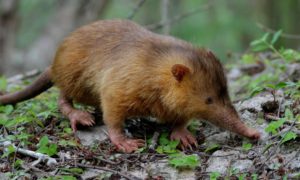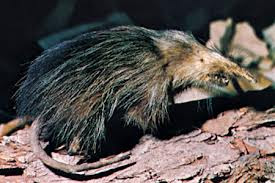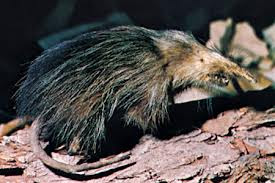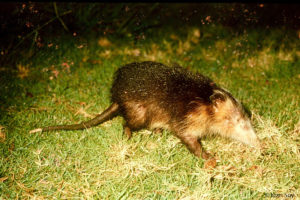 EL ALMIQUÍ O SOLENODÓN, UN MAMIFERO CUBANO ÚNICO SUPERVIVIENTE DE LA COLISIÓN DE ASTEROIDES EN MEXICO.
EL ALMIQUÍ O SOLENODÓN, UN MAMIFERO CUBANO ÚNICO SUPERVIVIENTE DE LA COLISIÓN DE ASTEROIDES EN MEXICO.
El solenodon cubano o almiqui (Solenodon cubanus), es una especie de eulipotifila endémica de Cuba. Pertenece a la familia Solenodontidae junto con una especie similar, el solenodon hispaniolano (Solenodon paradoxus). El solenodon es inusual entre los mamíferos ya que su saliva es venenosa.
El solenodon debería ser mas que famoso porque de alguna manera sobrevivió a la colisión de asteroides que mató a los dinosaurios, sin mencionar los próximos 66 millones de años de otras catástrofes, desde la Edad de Hielo hasta el surgimiento de destructores bípedos llamados Homo Sapiens (El Hombre).
Los investigadores no están completamente seguros de dónde se ubicaron las diversas poblaciones de solenodon cuando golpeó el asteroide, ya sea que ya estuvieran en las masas de tierra que se convertirían en la actual Cuba e Hispaniola o en el continente, pero creen que las poblaciones estaban cerca de la zona cero. El impacto del asteroide en Chicxulub, México.
“Es realmente notable que los solenodones sobrevivieron a este golpe directo, mientras que los ecosistemas globales colapsaron a su alrededor; no tenemos idea de cómo lo hicieron”, Samuel Turvey, experto en extinciones de hoy en día y miembro investigador principal de la Sociedad Zoológica de Londres. (ZSL), dijo.
Desde su descubrimiento en 1861 por el naturalista alemán Wilhelm Peters, solo 36 Almiquis habían sido capturados. En 1970, algunos pensaron que el solenodon cubano se había extinguido ya que no se habían encontrado especímenes desde 1890. Tres fueron capturados en 1974 y 1975, y las encuestas posteriores mostraron que todavía ocurría en muchos lugares en la provincia de Oriente central y occidental, en el extremo oriental de Cuba; Sin embargo, es raro en todas partes. Antes de 2003, el avistamiento más reciente fue en 1999, principalmente porque es una madriguera nocturna, que vive bajo tierra y, por lo tanto, rara vez se ve. El solenodon cubano encontrado en 2003, llamado Alejandrito, elevó el número hasta 37. Tenía una masa de 24 oz (0,68 kg) y estaba sano. Fue liberado nuevamente en la naturaleza después de dos días de estudio científico.
Con ojos pequeños y cabello castaño oscuro a negro, el solenodon cubano a veces se compara con una musaraña, aunque se parece mucho a los miembros de la familia Tenrecidae, de Madagascar. Mide 16–22 pulgadas (41–56 cm) de largo desde la nariz hasta la punta de la cola y se asemeja a una gran rata marrón con un hocico extremadamente alargado y una cola larga, desnuda y escamosa.
Willy Ley escribió en 1964 que el solenodon cubano estaba, si no extinguido, entre “los animales más raros de la tierra”. Fue declarado extinto en 1970, pero fue redescubierto en 1974. Desde 1982, ha sido catalogado como una especie en peligro de extinción, en parte porque solo cría una sola camada de una a tres en un año, y debido a la depredación por el pequeño invasor asiático. mangosta introducida por los humanos.
El rango de hogar del solenodon cubano se encuentra actualmente solo en Cuba. Esta especie es nocturna y viaja de noche a lo largo del suelo del bosque, buscando insectos y pequeños animales para alimentarse.
Esta especie tiene una dieta variada. Por la noche, buscan insectos y otros invertebrados, hongos y raíces en el suelo del bosque. Se trepan bien y se alimentan de frutas, bayas y brotes, pero también tienen hábitos más depredadores. Con el veneno de las glándulas salivales modificadas en la mandíbula inferior, pueden matar lagartijas, ranas, pájaros pequeños o incluso roedores. Parecen no ser inmunes al veneno de su propia especie, y se ha informado que los compañeros de jaula mueren después de las peleas.
Esta especie de animales es polígama, lo que significa que solo se encuentran para aparearse y los machos se aparean con múltiples hembras. Los machos y las hembras no se encuentran juntos a menos que estén apareándose. La pareja se reunirá, compañero, luego se separará. Los machos no participan en la crianza de ninguno de los jóvenes.
La investigación muestra que el solenodon evolucionó hace más de 70 millones de años, a tiempo para pasar el rato con los dinosaurios. Pero hoy en día, estos mamíferos únicos se enfrentan a un aluvión de amenazas que incluyen perros callejeros, gatos salvajes, mangostas invasoras y deforestación.
El solenodon cubano se considera en peligro de extinción, se ha temido que la especie se haya extinguido más de una vez. El programa EDGE de ZSL, que clasifica a los animales en función de su estado de amenaza y distinción evolutiva, enumera el par de solenodones como el número siete entre los 100 principales mamíferos. Según los expertos, “el hecho de que el solenodon haya sobrevivido a tantos trastornos hace que sea aún más trágico que estos” sobrevivientes de fósiles vivos “estén ahora en peligro de extinción debido a las actividades humanas”.
 THE ALMIQUI OR SOLENODON A UNIQUE CUBAN MAMMAL ASTERIOIDS SURVIVOR.
THE ALMIQUI OR SOLENODON A UNIQUE CUBAN MAMMAL ASTERIOIDS SURVIVOR.
The Cuban solenodon or almiqui (Solenodon cubanus), is a species of eulipotyplan endemic to Cuba. It belongs to the family Solenodontidae along with a similar species, the Hispaniolan solenodon (Solenodon paradoxus). The solenodon is unusual among mammals in that its saliva is venomous.
Since its discovery in 1861 by the German naturalist Wilhelm Peters, only 36 had ever been caught. By 1970, some thought the Cuban solenodon had become extinct since no specimens had been found since 1890. Three were captured in 1974 and 1975, and subsequent surveys showed it still occurred in many places in central and western Oriente Province, at the eastern end of Cuba; however, it is rare everywhere. Prior to 2003, the most recent sighting was in 1999, mainly because it is a nocturnal burrower, living underground, and thus is very rarely seen. The Cuban solenodon found in 2003, named Alejandrito, brought the number ever caught to 37. It had a mass of 24 oz (0.68 kg) and was healthy. It was released back into the wild after two days of scientific study were completed.
With small eyes and dark brown to black hair, the Cuban solenodon is sometimes compared to a shrew, although it most closely resembles members of the family Tenrecidae, of Madagascar. It is 16–22 in (41–56 cm) long from nose to tail-tip and resembles a large brown rat with an extremely elongated snout and a long, naked, scaly tail.
Willy Ley wrote in 1964 that the Cuban solenodon was, if not extinct, among “the rarest animals on earth”. It was declared extinct in 1970 but was rediscovered in 1974. Since 1982, it has been listed as an endangered species, in part because it only breeds a single litter of one to three in a year, and because of predation by the invasive small Asian mongoose introduced by humans.
The home range of the Cuban solenodon is currently in Cuba only. This species is nocturnal and it travels at night along the forest floor, looking for insects and small animals on which to feed.
This species has a varied diet. At night, they search the forest floor litter for insects and other invertebrates, fungi, and roots. They climb well and feed on fruits, berries, and buds, but have more predatory habits, too. With venom from modified salivary glands in the lower jaw, they can kill lizards, frogs, small birds, or even rodents. They seem not to be immune to the venom of their own kind, and cage mates have been reported dying after fights.
This species of animals are polygamist which means they only meet up to mate and the male mates with multiple females. The males and females are not found together unless they are mating. The pair will meet up, mate, then separate. The males do not participate in raising any of the young.
Research shows the solenodon evolved more than 70 million years ago – in time to hang out with dinosaurs. But today these unique mammals face a barrage of threats including stray dogs, feral cats, invasive mongoose, and deforestation.
There is a whole slew of reasons why the solenodon’s star should rise, including the fact that it’s one of the only venomous mammals. But most of all, the solenodon should be famous because it somehow survived the asteroid collision that killed off the dinosaurs, not to mention the next 66 million years of other catastrophes, from Ice Ages to the rise of bipedal destroyers named Homo Sapiens (The Human).
Surviving when asteroid’s impacted Mexico.
Researchers aren’t entirely sure where the various solenodon populations were located when the asteroid hit – whether they were already on the landmasses that would become modern-day Cuba and Hispaniola or on the mainland – but they think the populations were close to ground zero of the asteroid’s impact in Chicxulub, Mexico.
“It’s truly remarkable that the solenodons survived this direct hit, whilst global ecosystems collapsed around them – we have no idea how they did it,” Samuel Turvey, an expert on modern-day extinctions and a Senior Research Fellow with the Zoological Society of London (ZSL), said.
The Cuban solenodon is considered endangered, the species has been feared extinct more than once. The ZSL’s EDGE Programme, which categorizes animals based on their threatened status and evolutionary distinctness, lists the pair of solenodons as number seven in the top 100 mammals. According to experts “the fact that the solenodon survived so many upheavals makes it even more tragic that these ‘living fossil’ survivors are now in danger of extinction due to human activities.”
Agencies/ Wiki/ The Guardian/ Jeremy Hance/ Internet & Miguel Landestoy Photos/ Arnoldo Varona/ www.TheCubanHistory.com
THE CUBAN HISTORY, HOLLYWOOD.












